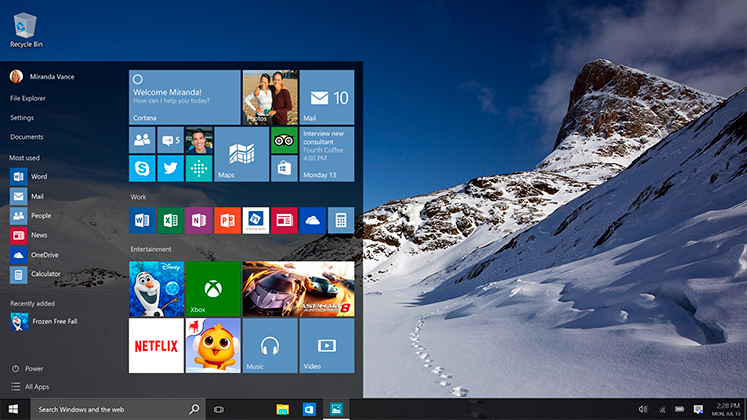Microsoft Calls Windows 10 the ‘Most Secure Windows Ever’
With days before Windows 10’s official release, Microsoft details some of the many security features aimed at keeping users and their data safe.
Windows 10 launches in two days as a free upgrade to eligible users, and in the hours leading up to July 29, Microsoft is working to ease the security concerns of millions of potential users.Microsoft’s flagship operating system has a spotty track record when it comes to security. But that’s in the past, according to the company.”Windows 10 has more built-in security protections to help safeguard you against viruses, phishing and malware, it’s the most secure Windows ever,” blogged the company’s Windows Team. “New features are now delivered through automatic updates, helping you to stay current and your system to feel fresh, so you’re free to do.”One way the Redmond, Wash., software behemoth is securing user data is by helping to mainstream biometric authentication with a new feature called Windows Hello. “Using just your fingerprint or even your face, Windows will greet you by name, providing a fast, secured, password-free way to log in,” wrote the group.
 An earlier post by Microsoft Corporate Vice President Joe Belfiore explained that some systems may already have the components required for Windows Hello. Devices with a fingerprint reader will be able to use Hello from Day One, he noted. Facial recognition will require specific hardware, however.”For facial or iris detection, Windows Hello uses a combination of special hardware and software to accurately verify it is you—not a picture of you or someone trying to impersonate you,” Belfiore wrote. “The cameras use infra-red technology to identify your face or iris and can recognize you in a variety of lighting conditions.”Anti-malware is built-in, and it’s powered by the company’s massive, globe-spanning cloud.”Windows Defender provides the defence you need; it is constantly updated to meet evolving threats as they are identified and is quick to detect and protect you against emerging malware, seen in the first critical hours,” added the Windows staffers. “Windows Defender uses a highly scalable and geo-distributed back end service in the cloud that leverage’s data from about 1 billion devices to draw lightning-fast insights and respond in hundreds of milliseconds.”Now that Internet Explorer is no longer the default browser, using the Internet is safer.”Microsoft Edge has been designed to be the most secure browser that we’ve ever released, and it uses advanced sandboxing technology to isolate what you’re experiencing on-line from your personal information, data and, of course, Windows itself,” said the company. Windows 10 is also on the lookout for phishing sites with another cloud-backed feature called SmartScreen, which evolved from IE’s reputation-based URL filtering technology.In addition to steering users clear of malicious sites, SmartScreen protects users “against socially engineered downloads of malicious software using a cloud-based app reputation service that is continuously evaluating the billions of new apps that are published to the Internet every year for malicious behaviour,” said Microsoft.
An earlier post by Microsoft Corporate Vice President Joe Belfiore explained that some systems may already have the components required for Windows Hello. Devices with a fingerprint reader will be able to use Hello from Day One, he noted. Facial recognition will require specific hardware, however.”For facial or iris detection, Windows Hello uses a combination of special hardware and software to accurately verify it is you—not a picture of you or someone trying to impersonate you,” Belfiore wrote. “The cameras use infra-red technology to identify your face or iris and can recognize you in a variety of lighting conditions.”Anti-malware is built-in, and it’s powered by the company’s massive, globe-spanning cloud.”Windows Defender provides the defence you need; it is constantly updated to meet evolving threats as they are identified and is quick to detect and protect you against emerging malware, seen in the first critical hours,” added the Windows staffers. “Windows Defender uses a highly scalable and geo-distributed back end service in the cloud that leverage’s data from about 1 billion devices to draw lightning-fast insights and respond in hundreds of milliseconds.”Now that Internet Explorer is no longer the default browser, using the Internet is safer.”Microsoft Edge has been designed to be the most secure browser that we’ve ever released, and it uses advanced sandboxing technology to isolate what you’re experiencing on-line from your personal information, data and, of course, Windows itself,” said the company. Windows 10 is also on the lookout for phishing sites with another cloud-backed feature called SmartScreen, which evolved from IE’s reputation-based URL filtering technology.In addition to steering users clear of malicious sites, SmartScreen protects users “against socially engineered downloads of malicious software using a cloud-based app reputation service that is continuously evaluating the billions of new apps that are published to the Internet every year for malicious behaviour,” said Microsoft.
![[HANDALA] - Ransomware Victim: SSV Blockchain Network 3 image](https://www.redpacketsecurity.com/wp-content/uploads/2024/09/image-300x300.png)
